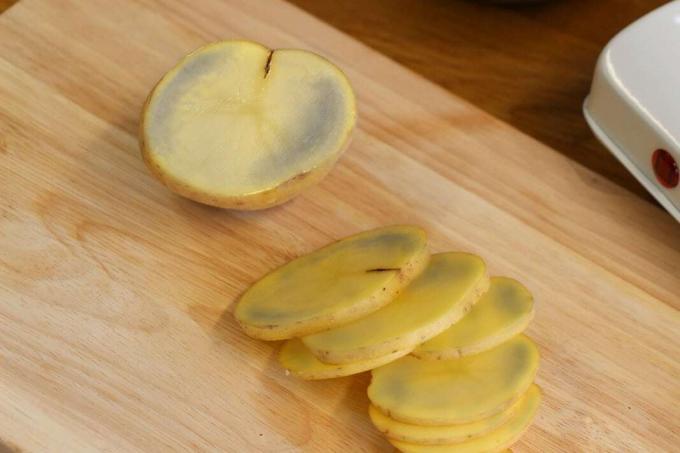
table of contents
- Dark spots on potatoes
- Black spots
- Brown or tuber rot
- Iron stain
- Potato scab
- Root killer disease / Rhizoctonia disease
- Dark spots after cooking
- Dark green spots
potatoes are among the most popular and versatile vegetables to use. Many hobby gardeners grow them year after year because they simply taste best from their own garden. The cultivation of potatoes is relatively unproblematic and even feasible with little space. Even if potatoes are actually relatively robust, they are susceptible to a wide variety of diseases. Some infest the potatoes and manifest themselves in dark spots, some of which can be hazardous to health. Are potatoes with dark spots still edible?
Dark spots on potatoes
The potato is not only an easy-care crop, it is also a traditional and very healthy vegetable. You can choose between numerous varieties, which in turn differ in taste, cooking stability, shelf life and maturing time. Regardless of the variety, it can happen that the tubers become blotchy. Fungi, viruses and bacteria can be responsible for this. But can you still eat potatoes with dark spots?
Black spots
There are diseases that can damage the potato tubers from the inside as well. Depending on when the infestation is detected and how severe it is, damaged tubers can have gray, brown, bluish or black discoloration. In addition to viruses, bacteria or fungi, these also arise from impact or pressure and can vary in severity depending on the temperature, soil and water supply. Even if these discolorations look a little unsavory, they can be generously cut out and the tubers in question eaten without hesitation they are completely harmless to health.
Brown or tuber rot
- Irregular, gray-brown areas, an indication of the dreaded brown rot
- Usually sunk in slightly, later hardened
- First show up on the leaves and stems
- In the case of advanced infestation, it can also spread to tubers
- Brown parts then also inside the potatoes
- There is hardly any separation from healthy tissue
- A fungus called Phytophtora infestans is responsible
- Fungus damages tubers from the outside in
- Spreads very quickly
- Is a trailblazer for other fungal pathogens
- This means that additional infestation with wet and dry rot pathogens is possible
Some types of spots can be cut out liberally and the tubers can still be eaten without any problems. This is not the case here, on the contrary. The tubers should be removed as quickly as possible at the first signs disposeto prevent spread. they are inedible, consumption could even pose a health hazard.
Iron stain
If potatoes have rust-brown areas of different sizes in the tuber, they are usually affected by what is known as iron staining. It is caused by a virus, the rattle virus. The discolored areas cannot be seen from the outside. They can even intensify during storage.

tip: Even if the affected tubers are basically still edible, in terms of taste they are actually no longer suitable for human consumption.
Potato scab
Potato scab caused by bacteria also leaves dark spots in potatoes. Since the herb is not infested, an infestation can hardly be detected early. Usually only the tubers are affected. Initially, they show brown areas with cracks, which become larger as the infestation progresses, fuse and cork. At some point they work their way down to the inside of the tuber. Potato scab does not make the tubers inedible. Discolored areas can generously cut out and the vegetables to be eatenas long as there are not too many.

tip: In order to prevent this disease, which is by no means serious, it is advisable to give preference to resistant varieties when growing.
Root killer disease / Rhizoctonia disease
Root killer disease can also cause symptoms such as dark discoloration. These so-called potato poxes form dark brown to black, sunken spots on the skin. They are no risk to health and also have no influence on the taste. Even if infected tubers can no longer win a beauty contest, these smallpox can usually be easily scraped off the skin or removed. remove. After that, the potatoes can be eaten without hesitation.
Dark spots after cooking
Dark spots that form in the potatoes after cooking are probably due to physiological damage, the so-called Cooking darkening. It is the result of a reaction between iron and chlorogenic acid and occurs during cooking. If the potatoes with the dark areas are not consumed immediately after cooking, the damage can be even more pronounced. Whether such dark areas form and in what intensity depends on the one hand on the supply of the plant, in particular with potassium and the respective variety.
Injuries to the tubers, for example during transport or storage, can also contribute. Such spotty potatoes may no longer look so tasty, but they are not a health hazard. If you cut out the spots, the tubers are edibleunless they pull through the entire tuber.
Dark green spots
- Dark green areas contain the poison Solanine
- Poison is also found in potato sprouts
- The longer the germs, the more toxic the potato
- Spots on and in the tubers form under the influence of light
- For example, if it is stored too light and too warm
- The more pronounced they are, the more solanine it contains
- If they are still small, cut them out generously
- Potatoes are usually still edible
- If they are already bigger, it is best to dispose of them
- Consumption of large amounts of this poison is hazardous to health
- Symptoms of poisoning, malaise, diarrhea, stomach pain and cramps

tip: Since the solanine is also present in the potato sprouts, you should refrain from eating tubers whose sprouts are longer than one centimeter.


